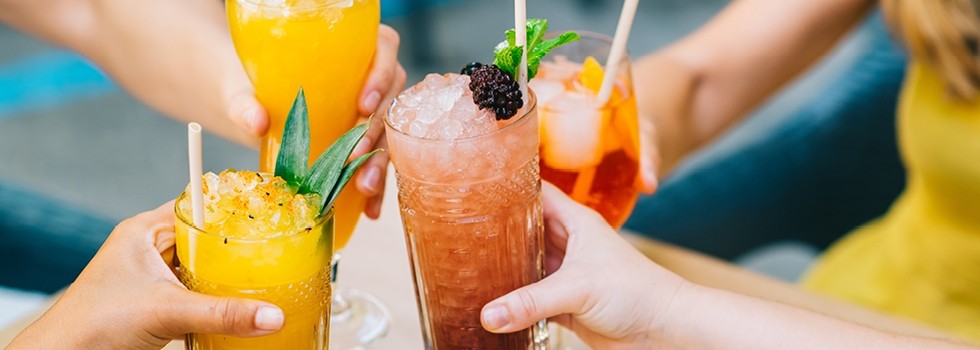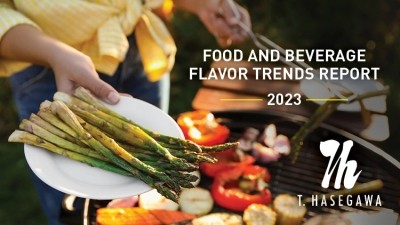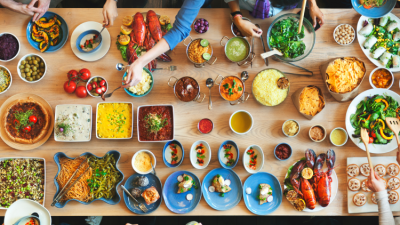Promotional Features
Molecular Mixology: How flavor science is shaking up the cocktail category and helping consumers beat the heat with a refreshing sip this summer
Warm summer months are perfect for refreshing fruity cocktails and other alcoholic beverages. While a tough economy is tightening consumer spending this summer, the flavor industry is driving innovation with a seasonal twist on classic cocktail recipes that provide real value.
For many people, summer is all about warm weather and cold beverages, group gatherings and outdoor activities. It’s a time of celebration, relaxation and hydration – with food and drink playing a major role in the season.
However, the summer of 2023 is shaping up to be quite different than in recent years. Looking back, 2022 began on an optimistic note as consumers were eager to move beyond the pandemic and resume group gatherings and dining out more frequently. However, by the end of the year, U.S. consumers experienced economic pressures and an inflationary squeeze, with out-of-home eating and drinking remaining short of pre-pandemic levels. While the economy continues to struggle, consumers are looking for ways to save money or make every dollar count in terms of value and experience. For many people, this means ‘nesting’ through at-home entertainment and gatherings, including a shift of drinking habits away from bars and restaurants, or seeking thrilling flavor experiences on a less-frequent basis at foodservice.
Whether it’s finely-crafted drinks at a restaurant or bar, a compelling RTD beverage, or a mixer at home, there’s a unique opportunity to deliver excitement and refreshment through cocktail flavors.
The Power of Premiumization
According to a recent Mintel survey, 34 percent of U.S. alcohol drinkers would choose to order fewer drinks on-premise when choosing to spend less. As inflation and economic concerns clamp down on discretionary spending for most households, U.S. drinkers have heightened expectations of the taste experience and flavor of their beverages and demand more from the category when dining out or at home.
With this shift in spending habits, the prevailing trend is premiumization within the alcohol category. Consumers are opting for ‘less, but better’ spirits, wines, beers and RTDs, and focusing on quality. According to Mintel, nearly a quarter of U.S. alcohol drinkers between the ages of 35-44 citing that they would buy less alcohol when choosing to save money but buy more expensive premium brands. Even among the RTD cocktail category, more than 31 percent of U.S. consumers over the age of 22 who drink pre-mixed cocktails are willing to spend more for products with premium ingredients included. To many consumers, high-quality cocktails and RTDs are seen as ‘affordable luxury’ and an accessible way to treat themselves.
Delivering Value through Flavor Technology
The path to premiumization is paved by flavor enhancement technology, which is especially pronounced within the cocktail category. In recent years, several new technologies have advanced the science of beverage flavors, producing cocktail concepts with complex, intriguing flavor profiles. California-based T. Hasegawa USA has been producing award-winning flavors and fragrances for over 120 years. As the subsidiary of one of the world’s top food and beverage flavor manufacturers, T. Hasegawa is leading the industry in technology designed to optimize the way cocktails and other beverages taste, and even replicate the complex flavors of nature itself.
Recently, T. Hasegawa introduced HASEAROMATM to the North American market. HASEAROMA is a proprietary novel technology that creates authentic sweet and savory flavors that reproduce the ‘first bite’ sensation of experiencing a food for the first time, packed with intricacy and nuances of flavor.
“One of the many benefits of this technology is that it enables a higher level of specificity than other compounded flavors,” said Austin Luft, senior flavor chemist at T. Hasegawa USA. “While many brands in the past may have opted for a simple mango, peach or orange flavor in product development, HASEAROMA can reproduce the specific flavor profile of an Alphonso mango or Ataulfo mango, a white peach or Golden Jubilee peach and a Clementine orange versus an American Navel orange. The expertise of our flavor chemists creating HASEAROMA allows us to refine flavors on a molecular level and develop products that stand out within the market and deliver value to consumers.”
Development of HASEAROMA flavors includes an extensive sensory analysis process which isolates specific flavor molecules within food and beverages. Chemists then assemble these molecules to add depth of flavor, long-lasting mouthfeel and authentic aroma.
“In many cases, the process for developing a new flavor with HASEAROMA can take up to 12-18 months, but the result is a wholly authentic flavor experience that is true to nature’s essence,” explained Luft.
Savoring the Sweetness of Summer
The summer months are synonymous with fruity food and beverage flavors. To many consumers, the best way to cool off and beat the heat during summer is with a cold cocktail featuring seasonal fruits and refreshing flavors. While traditional citrus, tropical fruits and berries are still among the most popular staples within the cocktail category, the flavor industry is broadening each of these categories to include exciting and exotic options. Traditional citrus flavors like orange, lemon and lime are being expanded with specific varietals like blood orange or yuzu, or even variations of classic global cocktail flavors like limoncello. Flavors that have traditionally been associated with summer such as tropical fruits like pineapple, coconut and banana are expanding to incorporate passionfruit, papaya, guava, kiwi and other exotic fruits to create new flavor combinations and cocktail creations both in foodservice and packaged products.
One of the biggest sources for flavor inspiration among the cocktail category is global cuisine, which offers a broad range of unconventional and exotic fruits that have distinct flavor profiles and also blend well with familiar favorites. The colorful streets of Latin America, Southeast Asia or the Middle East are becoming the source for fruit flavors like cherimoya, prickly pear cactus, tamarillo, lychee, cardamom, chokeberry, acai and cherry blossom. These flavors are usually introduced to U.S. consumers through foodservice mixologists before making their way into RTD cocktail and other grocery store products as they become mainstream.
The richness of flavor in cocktails is incredibly important. According to Mintel research, 50 percent of U.S. adults say that taste is the reason they drink alcohol and that’s even more pronounced among younger consumers, with over 78 percent of 22-34-year-olds agreeing that flavors drive their choice of alcohol.
“The alcoholic beverage category is undergoing immense changes in the way we approach product development,” explained Jeanene Martinez, T. Hasegawa’s director of applications. “While the category is quite diverse, alcoholic beverages need to deliver enjoyment and an elevated experience – most of which comes down to flavor. It’s an exciting time because there is a greater focus on flavors than ever before.”
Flavor Technology = Robust Refreshment
One of the most significant outcomes of the pandemic was a renewed interest in health and wellness, across all food and beverage categories. Consumers are acutely aware of the role foods and beverages play in their well-being, and even the alcohol category isn’t exempt from this trend. While many consumers still partake in alcoholic beverages, lifestyle changes during the pandemic have led to a more moderate approach to drinking, reducing frequency of alcohol consumption and increasing interest in low-ABV options or even non-alcoholic ‘mocktails.’
This renewed interest in health and wellness has boosted demand for BFY products across all food and beverage categories – including alcoholic drinks in the form of low-calorie and lighter reduced-sugar cocktails. In addition to limiting sugar and carbohydrate intake, many consumers are interested in alcoholic beverages that offer functional ingredients with some type of health benefit. For example, many RTD cocktails are leveraging green tea, berries and other superfoods that provide antioxidants and other tangible benefits.
The challenge that many brands face is creating clean-label alcoholic beverages that taste great with minimal sugar content while still masking the burning astringency of alcohol. Flavor manufacturers are leveraging innovative technologies and unique development processes to balance the requirements of a low-ABV, low-calorie beverage.
“When you remove an ingredient such as sugar or other sweeteners, this can sometimes compromise taste and mouthfeel, in addition to undesirable flavors in a beverage that can become more pronounced,” explained Briana Tran, beverage applications technologist at T. Hasegawa USA. “Our task is to reformulate the beverage to recover the optimal flavor profile, using technologies that either mask certain unwanted notes, or amplify desirable flavors that are already in the beverage.”
One such innovation that is being leveraged in the production of alcoholic beverages is T. Hasegawa’s BOOSTRACTTM, which is a proprietary flavor modulation technology. Boostract recovers the kokumi mouthfeel and full-bodied richness which is often lost when developing low-calorie alcoholic beverages.
“With technology like Boostract, we’re able to enhance the desirable flavors in beverages,” said Tran. “Boostract can amplify the natural flavors that are already present in the beverage and produce a much bolder taste and mouthfeel– even with a low-sugar formula.”
Getting Creative with Unconventional Cocktail Flavors
With consumers prioritizing their spending on immersive taste experiences as a representation of value, interest has never been greater in adventurous cocktail flavors. Many of these cocktail recipes focus on delivering maximum taste impact without relying on sugary syrups or other additives and are getting increasingly creative. Leading mixologists are exploring ways to blend dissimilar flavors – pairing fruits with seasonal ingredients, botanicals, fresh herbs and spices in cocktails – resulting in novel combinations like strawberry mint vodka gimlets, watermelon & basil vodka spritzes or raspberry & rhubarb margaritas. These cocktail creations blend familiar fruits that consumers love, with unexpected ingredients to offer a complex, rich flavor profile that is refreshing and provides an elevated taste experience.
Savory flavors have also grown in popularity, since they help balance the sweet nature of many fruit-flavored beverages. In a 2022 Mintel survey, more than 30 percent of participants expressed future interest in trying alcoholic beverages featuring chili pepper, basil or turmeric. Flavor manufacturers are focusing technology and resources on finely crafting these unconventional ingredients to produce great-tasting spirits that deliver the excitement that consumers are thirsty for in the cocktail category.
The role of flavor in cocktails and other alcoholic beverages is only going to continue growing each year. As consumers demand a higher level of flavor from their cocktails as a result of economic pressures, their palate will continue growing for more exotic refreshments. The flavor industry will play a major role in that growth, with new technology and innovations designed to meet the demand for more creative cocktails and other beverages.
Food and beverage brands who are looking to take their cocktail products to the next level of flavor can explore the possibilities by contacting T. Hasegawa USA at www.thasegawa.com or by calling (866) 965-0502.







